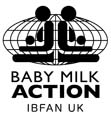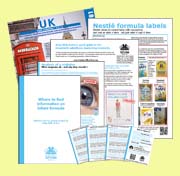IBFAN comments on WHO Proposed Global Targets for maternal, infant and young child nutrition
Click HERE for a PDF of IBFAN's COMMENTS on WHO's Proposed Global Targets for maternal, infant and young child nutrition. WHO Member States, regional economic integration organizations, as well as multilateral organizations are invited to submit their views by sending an email to nutrition@who.int by 27th February
If you agree with IBFAN's concerns please forward them to your health ministry as soon as you can. The Targets along with Resolution will go forward to the World Health Assembly 21-26th May.
The deadline for comments is MONDAY 27th February
Click here to see what happened at WHO Executive Board meeting in January.
The WHO background papers are all HERE.
http://www.who.int/nutrition/events/2012_consultation_proposed_globaltargets/en/
TEXT of our comments
IBFAN comments on WHO discussion paper (6 February 2012)Proposed global targets for maternal, infant and young child nutrition.
General comments :
IBFAN welcomes the multi-sectoral nature of the “Nutrition: Maternal, Infant and young child Nutrition: draft comprehensive implementation plan” and the setting targets for nutrition. However, to be effective and MSs motivated, the targets must not only be ambitious and meaningful, but also closely linked to actions that are proven to work. The plan must also recommend adequate safeguards to avoid conflicts of interests in principle and avoid promoting public-private partnerships such as SUN. Paragraph 44 of the Global Strategy on Infant and Young Child feeding should be incorporated to help ensure that the Plan does not undermine this important policy document.
The plan must emphasise the need for adequate sanitation, water and maternity protection, and the inter-related nature between nutrition, the right to food and health and sustainable livelihoods and economies, acknowledging the root causes of poor nutrition of women, such as structural violence, inequality and discrimination.
Global target 1: reduction of childhood stunting Target: 40% reduction of the global number of children under five who are stunted.
The Plan fails to mention that stunting is caused by sub-optimal nutrition during pregnancy and feeding in the first two years of life and that diarrhoea during infancy is a significant factorWHO has documented the link between stunting, diarrhoea and lack of optimal breastfeeding especially during the first six months. Good complementary feeding has also been recognised to significantly reduce stunting.
“Diarrhoea often leads to stunting in children due to its association with poor nutrient absorption and appetite loss. The risk of stunting in young children has been shown to increase significantly with each episode of diarrhoea,23 and diarrhea control, particularly in the first six months of life, may help to reduce stunting prevalence among children24.[ ]”
___________________________________________________________________
Global target 2: reduction of anaemia in women of reproductive age Target: 50% reduction of anaemia in non pregnant women of reproductive age
To help achieve Target 2 the Plan should:
• highlight the importance of delayed clamping of the umbilical cord in anaemia prevention in the newborn.
• highlight the fact that early initiation and increased frequency of breastfeeding decreases the amount of blood loss during the fourth stage of labor.
• highlight the fact that Lactational Amenorrhea achieved through exclusive and continued breastfeeding can preserve the iron stores in women. “Women in the EBF group were more likely to be amenorrheic at 6 months than women in the SF group, which conserves nutrients such as iron.”
Global Target 3: 50% reduction of low birth weight Target: 50% reduction of low birth weight
Overall, the text is missing a stronger emphasis on life cycle approach
___________________________________________________________________
Global Target 4: No increase in childhood overweight Target: 0% increase in the prevalence of overweight in children under five
Target 4 is unambitious and too accepting of the status quo – with no envisaged reversal of childhood obesity trends even in 10 years. Given the fact that optimal infant and young child feeding is important in obesity prevention, and that breastfeeding may help in the development of taste receptors and appetite control. The plan should highlight the current inappropriate promotion of baby foods and make reference to WHA Res 63.23 that calls on MSs to “… end inappropriate promotion of food for infants and young children…..” and WHA Res 55.25 which urges MSs “to ensure that the introduction of micronutrient interventions and the marketing of nutritional supplements do not replace, or undermine support for the sustainable practice of, exclusive breastfeeding and optimal complementary feeding”
Untested market-led approaches that push fortified ready-to-use foods and supplements, especially those high in sugar and fat, may undermine confidence in locally available and nutritious family foods and might also exacerbate the obesity problem. The positive effect of continued breastfeeding and optimal complementary feeding should be emphasised.
The plan should discourage food and beverage industry sponsorship of nutrition education. Such sponsorship is an even more complex problem than straightforward advertising, because it blurs the boundaries between advertising, marketing and education. The Plan should refer to the WHO Recommendations on the Marketing of foods and Non-alcoholic Beverages to Children that restrict marketing, including in ‘settings where children gather’ (e.g. schools) and to ‘avoid conflicts of interest.’
___________________________________________________________________
Global target 5: Increase exclusive breastfeeding rates in the first six months of life to at least 50% Target: increase of exclusive breastfeeding rates in the first six of life months to at least 50%
There seems to be some confusion about the indicator as expressed in the Title: “Increase exclusive breastfeeding rates in the first six months of life to at least 50 %.” This does not mean 50% at 6 months. However the Indicator refers to “percentage of infants aged 0-5 months who are fed exclusively with breastmilk.” While the Target Setting refers to: “…being exclusively breastfed until 6 months of age.”
The wording “exclusively breastfed until 6 months of age” should be used throughout Target 5.
Target 5 should obligate Member States to take action: to gather data on exclusive breastfeeding at 6 months, to work towards reducing the proportion of babies not being breastfed at 6 months and work towards the adoption of an indicator for 6 months of exclusive breastfeeding.
The Plan should emphasise that continued breastfeeding after 6 months provides a substantial proportion of a young child’s calorie and micronutrient needs.
| Attachment | Size |
|---|---|
| IBFAN on WHO Targets4.pdf | 167.78 KB |
- Login to post comments






